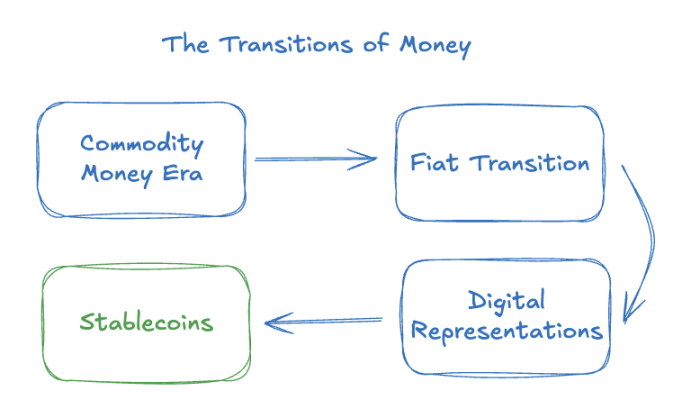Stablecoins, while relying on sovereign credibility like traditional fiat currencies, can separate trust in sovereignty from trust in corporate power.
Written by: Jacob Wittman, Legal Advisor at Plasma
Translated by: AiddiaoJP, Foresight News
What is Money?
In July 1944, as World War II was nearing its end, representatives from over 40 countries gathered in a small town in New Hampshire to answer a seemingly simple question: What is money, and who controls it? The Bretton Woods Conference was not the first time global leaders had explored this question, nor would it be the last. The debates surrounding gold, the dollar, and exchange rates laid the framework for the modern global financial system.
For thousands of years, every major monetary transformation has revolved around a fundamental question: What gives money its value? Debates about the value of money often involve its sovereignty and scarcity.
Each monetary transformation is less about the physical form of money and more about trust, power, and the rules of the game. Stablecoins represent the latest direction in this transformation, as trust and power are trending towards decentralization. We believe stablecoins are the most influential form of money today.

The Era of Commodity Money
The earliest known forms of money were commodities such as gold, silver, shells, and salt. These items had intrinsic or widely recognized value, derived from their physical scarcity. For example, the supply of gold is limited and must be obtained through mining, which is both difficult and expensive.
Scarcity brings credibility. If you hold a gold coin, you can trust it as a good "store of value" because no government or banker can simply print more gold out of thin air.

On the island of Yap in Micronesia, currency takes the form of massive limestone discs, some weighing several tons, quarried from Palau. Their value depends on size, transportation difficulty, and origin. Ownership is tracked through community consensus rather than physical movement, indicating that the power of money comes from shared belief rather than intrinsic value.
However, this form also brings limitations. Commodity money is heavy, difficult to transport, and inefficient in a rapidly growing global economy. These physical constraints hinder payment efficiency and obstruct economic growth. Long-distance trade requires a system that can transcend the weight of metals and capital limitations.
The Shift to Fiat Money
Ultimately, the combination of globalization and industrialization pushed commodity money towards collapse. Governments intervened and introduced fiat currency. Initially, paper money could be exchanged for gold or silver, gradually becoming widely accepted as money itself. The Bretton Woods system institutionalized this ecosystem by pegging the dollar to gold and linking other world currencies to the dollar.
This monetary system operated for about 25 years. However, by the late 1960s, the U.S. gold reserves could no longer support the dollar's global dominance. In 1971, President Nixon suspended the dollar's convertibility to gold, ushering in the era of unbacked fiat currency.
In the next phase of money, value derives from sovereign credibility rather than material scarcity. The dollar is valuable because the U.S. government says so, and the market and foreign governments believe it. Trust shifted from being physically supported to being politically and policy supported.
Such a profound transformation provided nations with powerful tools. Monetary policy became a core lever for economic management and geopolitical strategy. However, fiat money also brought vulnerabilities such as inflation, currency wars, and capital controls. In some cases, flexibility and stability are at odds. Today, the core question surrounding most modern currencies is not who can create money, but whether those in power are trustworthy and can maintain their value and utility over the long term.
The Digital Representation of Money
The rise of computers and the consumer internet posed an important question at the intersection of electrical engineering and finance: Can money be represented digitally in the digital world?
Projects like Mondex, Digicash, and eGold were early attempts in the 1990s and early 2000s to address this question. They promised to provide new electronic payment methods and stores of value. Ultimately, these projects failed due to regulatory pressure, technical flaws, and a lack of trust and product-market fit.
Meanwhile, electronic banking, credit cards, payment networks, and settlement systems became widespread. Importantly, these were not new assets. They were new representations of fiat currency, more scalable and better suited to the modern world. However, they still followed the same institutional trust and policy frameworks and, crucially, relied on closed technological systems and operational networks run by rent-seeking intermediaries.
The Emergence of Stablecoins
Stablecoins leverage this dynamic but take power away from corporations by using open, permissionless infrastructure. Fiat-backed stablecoins are designed to be hybrid. They inherit the credibility and efficiency characteristics of fiat currency while utilizing programmability and global accessibility.
By pegging stablecoins to reserve assets that can be redeemed at face value, they maintain predictable value by leveraging the credibility of sovereign nations like the United States. Issuing them on public blockchains allows for instant settlement, 24/7 operation, and seamless crossing of international borders.
We believe the emerging regulatory framework for stablecoins (which is an intrinsic component of their "monetary nature" today) should align with our core principles regarding how stablecoins should serve users:
Permissionless: Individuals should control their digital assets without burdensome account restrictions imposed by intermediaries.
Borderless: Geography should not determine whether someone can pay or receive money, nor should it dictate the time required to send or receive payments.
Privacy: Consumers should be able to engage in commercial activities freely, without fear of unwarranted surveillance by governments, the private sector, or other consumers.
Trustworthy Neutrality: Global capital flows should be free from discrimination, allowing people from all backgrounds to save and spend dollars as they wish.
Conclusion
Stablecoins are the next step in the evolution of money. They rely on sovereign credibility like traditional fiat currencies, but unlike electronic forms of fiat that preceded stablecoins, they separate trust in sovereignty from trust in corporate power. The best monetary assets exist based on the best monetary technologies and networks.
免责声明:本文章仅代表作者个人观点,不代表本平台的立场和观点。本文章仅供信息分享,不构成对任何人的任何投资建议。用户与作者之间的任何争议,与本平台无关。如网页中刊载的文章或图片涉及侵权,请提供相关的权利证明和身份证明发送邮件到support@aicoin.com,本平台相关工作人员将会进行核查。




